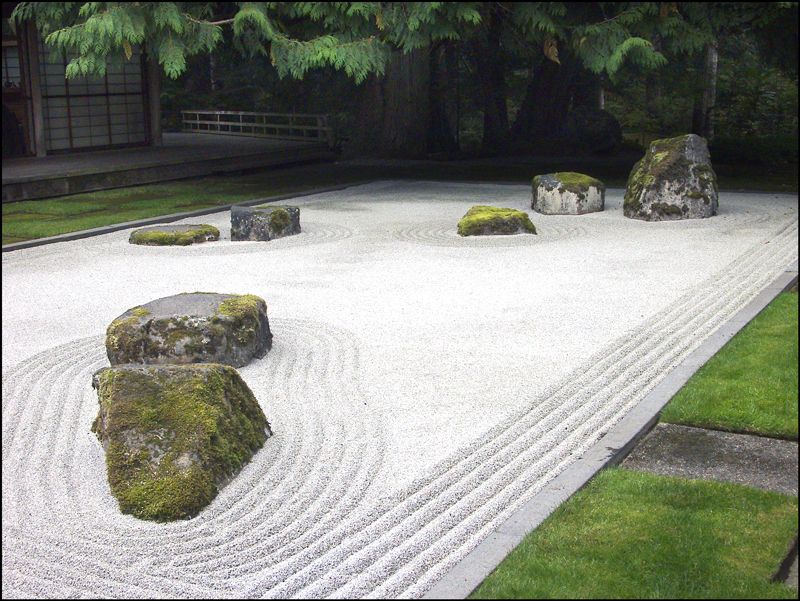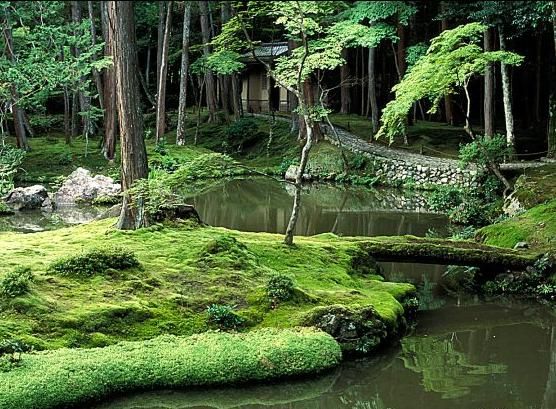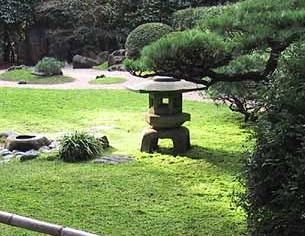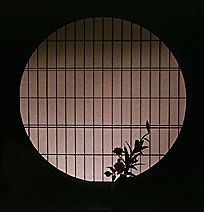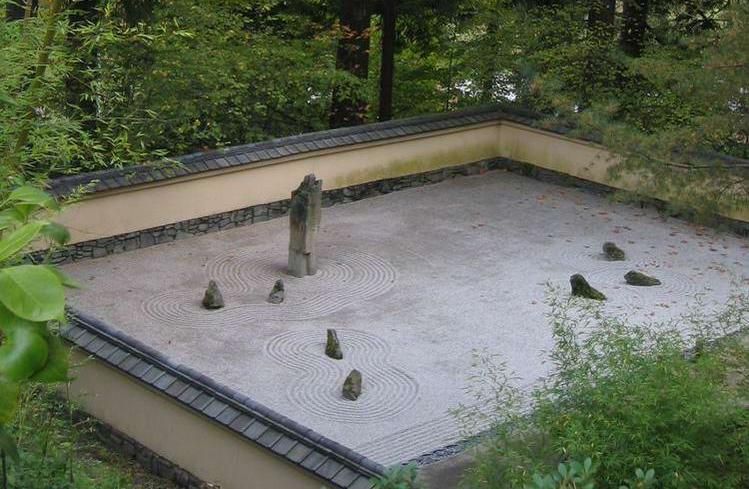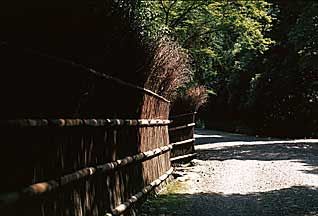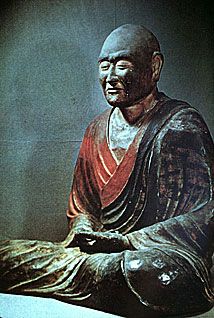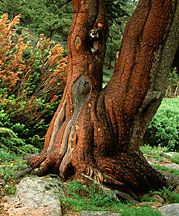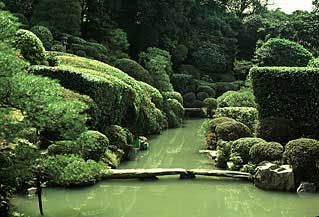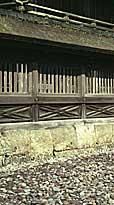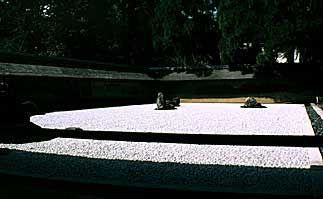Zen Principles in a japanese garden (Niwa)
|
|
|
|
A Japanese Garden is a representation of the universe and its elements - fire in the form of a stone or iron lantern, earth in the form of stone, and water, air, plant, and animal life in their true forms. Gardens essentially divide between the dry landscape and the pond garden types. Even in a dry garden there is always some water, notably in dripping basins or suggested by waterfall chains from the down spouts.
The garden path, or roji, is not merely a functional entry into the garden. It is a philosophical path separating the viewer step-by-step from the work-a-day world which he leaves behind. Its stones are placed with careful irregularity and lead indirectly rather than directly to often hidden or obscure places. Bends in the path, or larger stones, are stopping points for vistas or views, representing meditative pauses in the personal experience of contacting the universe via the garden experience.
Stones generally form the basic supporting framework of a Japanese garden,and they should look as though they had always lived in the spot in which one sees them. Jagged stones are used to suggest mountain areas and water-worn pebbles are used in stream courses and along shorelines. These landscape effects are often more symbolic than realistic. For example, there is generally an island in either a stream or pond which suggests the island of everlasting life, or Nirvana - a place without time or space of ultimate retirement in peace and tranquillity. Its symbols may be a stone representing a turtle, or a tree form representing a crane - symbols of longevity and the good life - and such additional happiness symbols as the shochikubai or three friends of the new year consisting of pine, bamboo and plum. Some of these symbols are entirely abstract in their form.
A Japanese Garden is not planted with the idea of presenting a display of flowers. The Japanese often enjoy their gardens most in the austere conditions of winter when the trees are bare and the foliage is at a minimum. They often trim camellias, azaleas, and other flowering shrubs so as to produce a minimum of flowers. Flowers are never used in beds or borders. In fact, a severe discipline governs the use of flowers which are used at only one point in the house, the tokonoma, a special architectural alcove built for the purpose. Fresh flowers or plant materials are never used decoratively on the dining table or at odd points about the house; never worn as corsages; never used at weddings or funerals. Essentially as a matter of philosophy, flowers and plants are considered to have a very special life of their own as an expression of nature and are never used as decorations.
The principles which govern these aspects of the garden come from the philosophy of Zen and they can mean not only one thing alone, but may have correlative meanings at the same time. No one principle therefore necessarily contains the whole meaning on its own.
The Zen Principles which relate to the Niwa:
1. Fukinsei - asymmetry or dissymmetry
2. Kanso - simplicity
3. Koko - austerity, maturity, bare essentials, venerable
4. Shizen - naturalness, absence of pretense
5. Yugen - subtly profound, suggestion reather than revelation
6. Datsuzoku - unworldliness, transcendence of conventional
7. Seijaku - quiet, calm, silent
|
1. Fukinsei is the principle controlling the balance of a composition is always asymmetrical. Its division of space, in either the second or third dimensions of spatial organization uses an irregular division. Monumental Stone Lantern from Miyanoshita in the third dimension consisting of height, width and depth. |
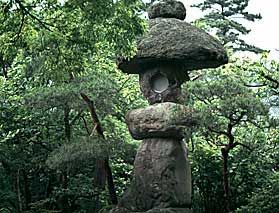 |
2. The second principle, Kanso, relates to basic simplicity and the elimination of the ornate. Things expressing simplicity are by their nature truthful and reserved. Kanso involves a sense of cleanliness, things which are fresh and neat, frank but never over-embellished. Things of Kanso nature are never florid in style.
|
|
|
|
|
Moon window in an endless circle with the simple flower arrangement, Ikebana |
Garden in the simplicity of stones and gravel only, without flowers or large plants |
Bush fence - function and beauty in simple expression |
3. The koko principle involves a feeling of the austere but with a sense of maturity. It carries the qualities of age and venerability coupled with a weathered appearance. Visual elements are reduced to their basic bare bones, without sensuous aspects. Koko involves things which seem stern, ascetic and forbidding in appearance. It involves a sense of the harsh, the severe and the rigidly abstemious.
|
|
|
|
|
The Silhouette of Izumo Shrine's stark contrast shows us the bare bones of this subject |
Priest Ganjin with the look of enlightenment in an aged face |
Ancient camphor tree at Miyajima -showing the effects of venerable age |
4. Shizen involves a true naturalness as distinct from raw nature. It is involved with a sense of creativity and purpose distinct from the naive or accidental. Nothing involving Shizen should be forced or self-conscious. In fact true naturalness is a negation of the naive and the accidental. Shizen has about it a sense of artlessness and an absence of pretense or artificiality, but it involves full creative intent and should never be forced. The apparent naturalness and the sense of spontaneous nature so evident in the NIWA is a manifestation of Shizen.
|
|
|
|
|
The Garden of Chishaku - is a creative grouping of natural forms to express nature, not to copy it |
Eccentric beams of Himeji castle follow the natural growth of the tree |
Diagonal lines of fence and gravel at Izumo shrine present a truthful function expressed in aesthetic terms |
5. Yugen avoids the obvious and relates to the subtleties of nature. It is the suggested rather than the totally revealed aspects of it. It involves partly hidden views of indistinct areas sometimes relative to shadows, partial reflections and darkly revealed forms. Yugen hints at extra layers of meaning which are not at first obvious to the casual viewer. It also involves things which are subtlely profound. A niwa is a collection of subtleties in its pond reflections, stone and sand symbolisms and shadow areas.
|
|
|
|
|
Bamboo shadows - subtle shadows of bamboo on bamboo |
Mt. Fuji - Ephemeral view. More is left unsaid than is said in this view of the mountain |
Dark and light of nature condition at Ryoan-ji. Strong darks reveal no detail in this view of the Zen garden |
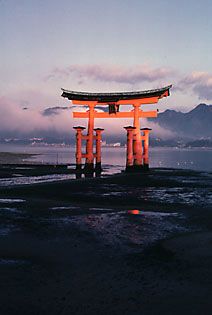 6. Surprise is the immediate effect of an expression involving Datsuzoku. It involves a transcendence of conventional ideas and traditional usage. One should be astonished in its presence and realize a freedom from restrictive laws or any kind of bondage in its use. It may be the seed-bed of ultimate creativity.
6. Surprise is the immediate effect of an expression involving Datsuzoku. It involves a transcendence of conventional ideas and traditional usage. One should be astonished in its presence and realize a freedom from restrictive laws or any kind of bondage in its use. It may be the seed-bed of ultimate creativity.
The very creation of the niwa out of the raw materials of nature and its success in revealing the essence of natural things to us is an ultimate surprise. Many surprises await at almost every turn in a Japanese Garden.
To the right you can see the Tori from Miyajima. Surprise that it is in the water.
7. The calming influence one feels on entering a Japanese Garden is due to Seijaku, the principle that relates to quietness and stillness. Silence and tranquillity prevail and all sense of disturbance is absent. Reflections on water often express this principle. Its opposite is noise and disturbance. An old proverb says stillness is activity, therefore Seijaku is thought of as an active state though its effect is one of calm and unruffled solitude. Its timely and seasonal character has to do with late autumn or early spring, and it is evident at dawn and dusk, in the moonlight and in snow-covered gardens.
Articole asemănătoare
-
Strugurii Blaufrankisch
Daca are suficient soare si un pamant fertil, Blaufrankisch sau Lemberger este o buna alegere pentru a obtine vinuri rosii de calitate, taninoase, aromate, cu note de fructe de padure, cu o nuanta inchisa, dar si pentru varietati mai usoare, fructate, vinuri de desert in care veti intalni gusturi si note surprinzatoare.
-
Garoafa, floarea celor nascuti in ianuarie
Toti cunoastem garoafele pentru ca fiecare am daruit candva un buchet de garoafe, insa putini stim ca ea este prin excelenta floarea persoanelor nascute in luna ianuarie.
-
Gradinaritul in saci, o solutie de viitor pentru combaterea saraciei
Rwanda este tara cu cea mai mare densitate a populatiei in Africa sub-sahariana. Numarul crescut de locuitori si deficitul de teren cultivabil constituie principalele probleme care determina cazurile de malnutritie. In jurul orasului Kigali, oamenii detin prea putin teren, sau mai rau decat atat, nu poseda nici macar un loc unde sa creasca produse vegetale.
-
De ce flori ne bucuram in noiembrie?
Desi vremea devine tot mai intunecata si mai rece in noiembrie, exista unele flori care prospera chiar si in aceste conditii dificile. Spre incredintare va prezentam o lista a celor mai populare flori care se intalnesc in perioada aceasta a anului in gradinile zonelor temperate ale globului.
-
Armonizarea vinurilor cu mancarurile la masa
Inceputul viticulturii pe teritoriul tarii noastre se pierde in negura timpului. Din unele scrieri antice aflam ca stramosii geto-daci cunosteau deja procesul de obtinere a vinului. Homer de pilda aminteste in a doua jumatate a secolului al VIII-lea i. Hr., in epopeea Iliada, ca "razboinicii greci s-au dus in Tracia sa gaseasca vinul".
